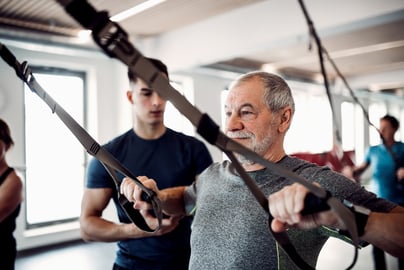 Working with a senior population, the most commonly asked question I probably get is “How can I strengthen my legs/back/core.. etc?” As exercise professionals, we already know how as far as the exercise prescription goes, but with seniors, modality often becomes a challenge. Our clients typically have a whole range of physical issues to deal with including joint pain, balance issues, and overall weakness so the traditional sit-to-stand exercises aren’t always applicable. That’s where the TRX suspension training system comes into play.
Working with a senior population, the most commonly asked question I probably get is “How can I strengthen my legs/back/core.. etc?” As exercise professionals, we already know how as far as the exercise prescription goes, but with seniors, modality often becomes a challenge. Our clients typically have a whole range of physical issues to deal with including joint pain, balance issues, and overall weakness so the traditional sit-to-stand exercises aren’t always applicable. That’s where the TRX suspension training system comes into play.
The TRX was originally developed for Navy SEALS and other elite level soldiers and athletes, but over the years, it has worked its way into home gyms, rehab clinics, and even senior living communities. The TRX is portable, adjustable for all heights, allows you to control ROM, challenges core strength with almost every single exercise, and has hundreds of possible exercises your clients can enjoy.
When it comes to building strength in seniors, ACSM guidelines and other research will tell us that more repetitions are effective when it comes to older adult populations. But there is also evidence eccentric movements are also beneficial due to its reduced oxygen requirement lowering the metabolic demand, and the fact that muscles can move more weight in the lengthening phase versus the shortening phase (concentric).The TRX allows the use of both approaches to strength building, without any additional equipment, such as free weights.
For example, If I am working with a client who can only perform a few sit to stands by pushing off of their thighs or arm rests of a chair, simply prescribing more sit-to-stands may not be the best route, especially if the clients gets frustrated. Instead, I could place the client in a chair in front of a TRX, and use it for an assisted sit-to-stand! Simply have the client start standing up, and begin the descent down into the chair, making sure the hips are hinged back, the knees are bending and in alignment (as best as they can be) and have them sit as gently as possible. Then, perform the same exercise in reverse to stand up. Since the client already struggle to stand up without pushing, they can use the TRX to help pull themselves up, while pushing through the legs. Once the client has a feel for the exercise and can perform it safely, you could then start modifying the repetitions, intensity, and better yet, progress from sit-to-stand to a TRX assisted squat!
And that was just one example. If you have a client that’s looking to improve posture, a bit of upper body strength and core, the TRX row is a very easy to teach and effective. With the TRX adjusted to the proper height, have the client stand with the straps in both hands, with soft knees, shoulders down, and core engaged. Make sure you are standing behind them for safety purposes. Have client begin to lean back, allowing the elbows to leave their sides and begin to straighten out. Then, once the full ROM has been achieved, have the client drive their elbows back while squeezing the scapula together, returning to the starting position.
With limitless exercise possibilities, portability, and affordability, the TRX is perhaps the ultimate strength builder for seniors. The TRX company themselves have put out hundreds of videos on how to teach the exercises, ques, and progressions, so there are plenty of resources out there on how to use it. They even have their own certification courses! I would recommend any and all senior living communities to invest in the TRX and the education of their fitness professionals.

